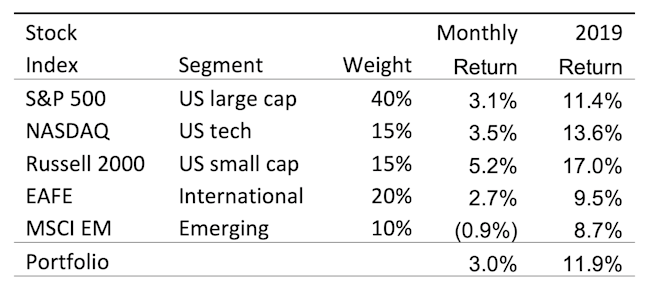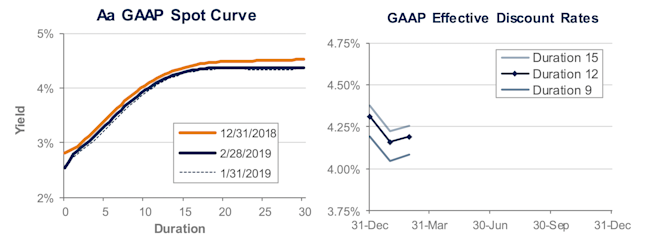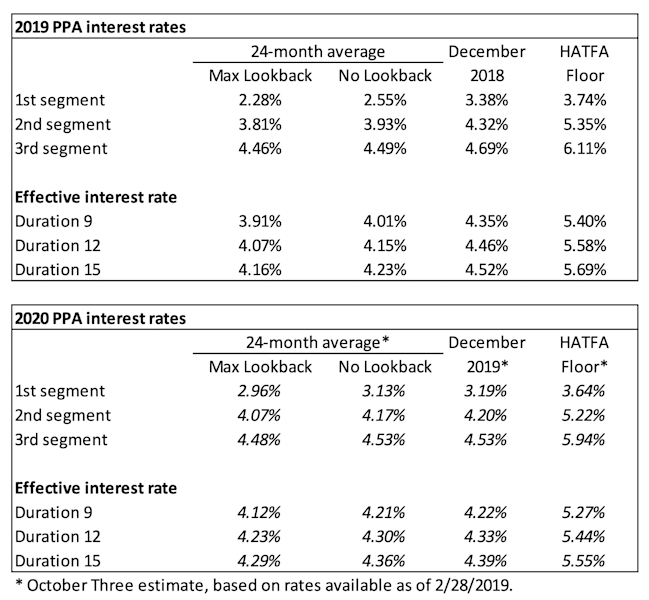February 2019 Pension Finance Update
Pension finance enjoyed a second straight good month to start 2019, as both stocks and interest rates moved higher. Both model plans we track[1]improved in February: Plan A gained 2% and is now up 5% for the year, while Plan B gained less than 1% and is ahead almost 2% through the first two months of 2019:[1]Plan A is a traditional plan (duration 12 at 5.5%) with a 60/40 asset allocation, while Plan B is a largely retired plan (duration 9 at 5.5%) with a 20/80 allocation with a greater emphasis on corporate and long-duration bonds. We assume overhead expenses of 1% of plan assets per year, and we assume the plans are 100% funded at the beginning of the year and ignore benefit accruals, contributions, and benefit payments in order to isolate the financial performance of plan assets versus liabilities.
Pension finance enjoyed a second straight good month to start 2019, as both stocks and interest rates moved higher. Both model plans we track[1] improved in February: Plan A gained 2% and is now up 5% for the year, while Plan B gained less than 1% and is ahead almost 2% through the first two months of 2019:

Assets
February was another good month for most categories of stocks. The table below summarizes returns on various stock indices included in our model portfolio:

Bonds slipped in February as interest rates crept higher. Treasuries lost less than 1% last month and are now flat for the year, while corporate bonds were flat last month and remain up 1%-3% for the year. A diversified bond portfolio lost a smidgen in February but is still up 1%-2% so far in 2019.
Overall, our traditional 60/40 portfolio gained almost 2% in February and is now up 7% for the year, while the conservative 20/80 portfolio gained less than 1% last month and is up 3%-4% during 2019.
Liabilities
Pension liabilities (for funding, accounting, and de-risking purposes) are driven by market interest rates. The graph on the left compares our Aa GAAP spot yield curve at December 31, 2018, and February 28, 2019, and it also shows the movement in the curve last month. The graph on the right shows our estimate of movements in effective GAAP discount rates for pension obligations of various duration during 2019:

Corporate bond yields rose a few basis points in February, leaving pension liabilities essentially unchanged during the month. For the year, liabilities remain up 2%-3%.
Summary
So far in 2019, pension sponsors have recouped the majority of losses suffered in late 2018. The graphs below show the progress of assets and liabilities for our two model plans this year:

Looking Ahead
Pension funding relief has reduced required plan funding since 2012, but under current law, this relief will gradually sunset by 2022, increasing funding requirements for pension sponsors that have only made required contributions.
Discount rates moved up a smidgen last month. We expect most pension sponsors will use effective discount rates in the 3.9%-4.3% range to measure pension liabilities right now.
The table below summarizes rates that plan sponsors are required to use for IRS funding purposes for 2019, along with estimates for 2020. Pre-relief, both 24-month averages and December ‘spot’ rates, which are still required for some calculations, such as PBGC premiums, are also included.

[1]Plan A is a traditional plan (duration 12 at 5.5%) with a 60/40 asset allocation, while Plan B is a largely retired plan (duration 9 at 5.5%) with a 20/80 allocation with a greater emphasis on corporate and long-duration bonds. We assume overhead expenses of 1% of plan assets per year, and we assume the plans are 100% funded at the beginning of the year and ignore benefit accruals, contributions, and benefit payments in order to isolate the financial performance of plan assets versus liabilities.
